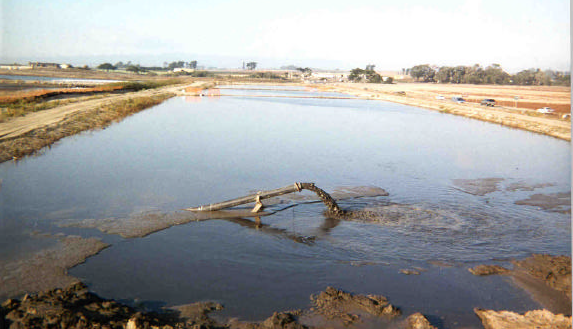A new NOAA-funded study outlines systemic changes that could be made in Southern California to encourage beneficial reuse of sediment to support coastal resilience.
Sediment management is increasingly important as urbanization and climate change alter sediment fluxes, relative sea level, and coastal erosion around the world. Sediment is needed to enhance marsh accretion rates, raise the grade elevation of development, and build up beaches and dunes. Repurposing local sources of sediment for these applications, material typically available from dredging, is more sustainable than transporting sediment to and from distant locations. However, in many locations, the beneficial reuse of sediment remains a concept or is constrained to small-scale projects.

The Moss Landing Harbor (California) project is an example of a small- to medium-sized beneficial sediment reuse project. The Moss Landing Harbor District (MLHD) was unable to dredge their commercial and recreational harbor as a result of elevated pesticides and a lack of a suitable upland disposal site. The MLHD, working closely with federal and state agencies, obtained permits to develop an upland drying and processing site. In conjunction with this site, the MLHD used cement additives to provide base material for fill-in road construction, parking lots, and the development of a new recreational use facility. Credit: Port of Long Beach, California. 2000.
Researchers from the University of California Irvine, the Southern California Coastal Water Research Project, and the Tijuana River National Estuarine Research Reserve interviewed sediment managers and regulators in the Newport Bay and Tijuana River watersheds to identify barriers they face in their pursuit of reusing sediment from areas where it is a problem to areas where it can benefit the ecosystem and the community. The research team identified regulatory, technical, psychological, financial, and interorganizational barriers to the beneficial reuse of sediment along the coast.
Regulatory inflexibility was a big obstacle identified, as federal, state, and local agencies often have different permitting requirements and processes that are not compatible. Technical barriers associated with matching sediment types between dredging sites and final locations can also limit placement options. Even psychological aspects come into play, such as public perception that sediment placement may damage the attraction or health of the placement site.
The researchers provided several recommendations to remove these barriers, some of which are already being attempted by managers in the region, including, streamlining the permitting process, developing strong outreach communications, and incorporating the financial benefits of sediment reuse in project planning (see study for a detailed list of recommendations).
The study is part of a project supported by the NCCOS Effects of Sea Level Rise Program.

Barriers and Opportunities for Beneficial Reuse of Sediment to Support Coastal Resilience. Credit: Ulibarri et al., 2020
 Official websites use .gov
A .gov website belongs to an official government organization in the United States.
Official websites use .gov
A .gov website belongs to an official government organization in the United States. Secure .gov websites use HTTPS
A lock or https:// means you’ve safely connected to the .gov website. Share sensitive information only on official, secure websites.
Secure .gov websites use HTTPS
A lock or https:// means you’ve safely connected to the .gov website. Share sensitive information only on official, secure websites.